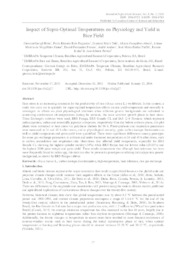Impact of Supra-Optimal Temperatures on Physiology and Yield in Rice Field.
Impact of Supra-Optimal Temperatures on Physiology and Yield in Rice Field.
Autoria: BRITO, G. G. de; FAGUNDES, P. R. R.; TELÓ, G. M.; ABREU, A. G. de; MAGALHAES JUNIOR, A. M. de; FRANCO, D. F.; ANDRES, A.; PARFITT, J. M. B.; KUHN, R. A.; PETRINI, J. A.
Resumo: Heat stress is an increasing constraint for the productivity of rice (Oryza sativa L.) worldwide. In this context, a study was carry out to quantify the supra-optimal temperature effects on rice yield-components and secondly to investigate its effects on plant physiological attributes when different genetic backgrounds are submitted to contrasting environment air-temperatures during the anthesis, the most sensitive growth phase to heat stress. Three Embrapa's cultivars were used, BRS Pampa, BRS Sinuelo CL and IAS 12-9 Formosa which represent indica/japonica, indica and essentially japonica subspecies, respectively. One day before anthesis phase, sub plot plants were submitted to heat stress via polythene shelters for 96 h. Photosynthesis and respiration parameters were measured at 24 and 48 h after stress, and at physiological maturity, grain carbon isotope fractionation as well as yield components and grain yield were quantified. There were significant differences among genotypes for some gas exchange parameters at ambient and under increased temperatures at 24 and 48 h after stress, such as carbon assimilation and respiration rate. Heat-stress also affected yield components, especially for BRS Sinuelo CL showing the highest spikelet sterility (54%) while BRS Pampa had the lowest value (20.80%) and the highest 1000-grain weight and grain yield. These results demonstrate that although heat tolerance has been more frequently found in indica spp, this trait can also be present in genotypes combining indica/japonica genetic background, as shown by BRS Pampa cultivar.
Ano de publicação: 2016
Tipo de publicação: Artigo de periódico
Unidade: Embrapa Clima Temperado
Palavras-chave: Arroz, Carbon, Carbon isotope discrimination, Carbono, Fisiologia, Gas exchange, Heat treatment, High-temperature, Isotopes, Oryza Sativa L, Oryza sativa, Rice, Rice gas exchange, heat tolerance
Observações
1 - Por padrão são exibidas publicações dos últimos 20 anos. Para encontrar publicações mais antigas, configure o filtro ano de publicação, colocando o ano a partir do qual você deseja encontrar publicações. O filtro está na coluna da esquerda na busca acima.
2 - Para ler algumas publicações da Embrapa (apenas as que estão em formato ePub), é necessário ter, no celular ou computador, um desses softwares gratuitos. Sistemas Android: Google Play Livros; IOS: iBooks; Windows e Linux: software Calibre.
Acesse outras publicações
Acesse a Base de Dados da Pesquisa Agropecuária (BDPA) para consultar o acervo completo das bibliotecas da Embrapa.

